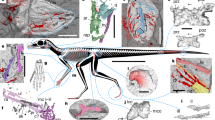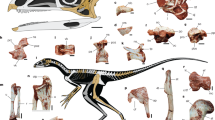Abstract
In fossilised vertebrates, the presence of soft tissues is the most obvious way to determine aspects of anatomy and functional morphology; however, occurrences are rare and other lines of evidence must be sought to indicate its extent and strength. For example, pterosaurs possessed a large wing membrane that enabled powered flight but other tissues are not widely preserved. A semi-quantitative analysis comparing skeletal articulation and completeness of the pterodactyloid Pterodactylus and non-pterodactyloid pterosaur Rhamphorhynchus from Solnhofen-type deposits implies there were anatomical differences between soft-tissue structure and attachments articulating skeletal joints of each. Typically, skeletons of Pterodactylus disarticulate to a greater extent than those of Rhamphorhynchus, which in turn suggests decay progressed to more advanced states in the former. However, this generalisation masks a mosaic of differences between different body parts, for example Rhamphorhynchus tends to lose the wings as complete units but retains a complete and still articulated tail in a greater number of specimens than Pterodactylus.





Similar content being viewed by others
References
Barthel KW (1970) On the deposition of the Solnhofen lithographic limestone (Lower Tithonian, Bavaria, Germany). Neues Jahrb Geol P-A 135:1–18
Barthel KW (1978) Solnhofen: ein Blick in die Erdgeschichte. Ott Verlag, Thun
Barthel KW, Swinburne NHM, Conway Morris S (1990) Solnhofen: a study in Mesozoic paleontology. Cambridge University Press
Beardmore SR (2012) The skeletal taphonomy of vertebrates from the Triassic and Jurassic. Unpublished PhD Thesis, University College, Dublin
Beardmore SR, Orr PJ, Manzocchi T, Furrer H, Johnson C (2012) Death, decay and disarticulation: a method of modelling the skeletal taphonomy of marine reptiles demonstrated using Serpianosaurus (Reptilia; Sauropterygia). Palaeogeogr Palaeoclimatol 337:1–13
Bennett SC (1995) A statistical study of Rhamphorhynchus from the Solnhofen limestone of Germany: year-classes of a single large species. J Paleontol 69:569–580
Bennett SC (1996) Year-classes of pterosaurs from the Solnhofen limestone of Germany: taxonomic and systematic implications. J Vertebr Paleontol 16:432–444
Bennett SC (2008) Morphological evolution of the forelimb of pterosaurs: myology and function. Zitteliana B28:127–141
Bennett SC (2013) New information on body size and cranial display structures of Pterodactylus antiquus, with a revision of the genus. Palaeont Z 87:269-289
Bonde N, Christiansen P (2003) The detailed anatomy of Rhamphorhynchus: axial pneumaticity and its implications. In: Buffetaut E, Mazin J-M (eds) Evolution and palaeobiology of pterosaurs. Geol Soc Spec Publ 217:217–232
Claessens LPM, O’Connor PM, Unwin DM (2009) Respiratory evolution facilitated the origin of flight and aerial gigantism. PLoS One 4:e4497
Dalla Vecchia FM (2003) New morphological observations on Triassic pterosaurs. In: Buffetaut E, Mazin J-M (eds) Evolution and palaeobiology of pterosaurs. Geol Soc Spec Publ 217:23-33
Dietl G, Schweigert G (2001) Im Reich der Meerengel – Fossilien aus dem Nusplingen Plattenkalk. Pfeil, Munich, p 144
Dietl G, Schweigert G (2004) The Nusplingen lithographic limestone—a ‘fossil Lagerstätte’ of late Kimmeridgian age from the Swabian Alb (Germany). Riv Ital Paleontol Stratigr 110:303–309
Elgin RA, Hone DWE, Frey E (2011) The extent of the pterosaur flight membrane. Acta Palaeontol Pol 56:99–111
Frey E, Tischlinger H (2012) The late Jurassic pterosaur Rhamphorhynchus, a frequent victim of the ganoid fish Aspidorhynchus? PLoS One 7:e31945
Frey E, Tischlinger H, Buchy M-C, Martill DM (2003) New specimens of Pterosauria (Reptilia) with soft parts with implications for pterosaurian anatomy and locomotion. In: Buffetaut E, Mazin J-M (eds) Evolution and palaeobiology of pterosaurs. Geol Soc Spec Publ 217:233–266
Häckel E (1866) Generelle Morphologie der Organismen. Reimer, Berlin
Hammer Ø, Harper DAT, Ryan PD (2001) PAST: Paleontological Statistics Software Package for Education and Data Analysis. Palaeontol Electron 4. http://palaeo-electronica.org/2001_1/past/issue1_01.htm
Hone DWE, Henderson DM (2014) The posture of floating pterosaurs: ecological implications for inhabiting marine and freshwater habitats. Palaeogeogr Palaeoclimatol 398:89–98
Hone DWE, Henderson DM, Therrien F, Habib MB (2015) A specimen of Rhamphorhynchus with soft tissue preservation, stomach contents and a putative coprolite. Peer J 3:e1191
Jouve S (2004) Description of the skull of a Ctenochasma (Pterosauria) from the latest Jurassic of eastern France, with a taxonomic revision of European Tithonian Pterodactyloidea. J Vertebr Paleontol 24:542-554
Kellner AW (1996) Reinterpretation of a remarkably well preserved pterosaur soft tissue from the Early Cretaceous of Brazil. J Vertebr Paleontol 16(4):718–722
Kellner AWA, Wang X, Tischlinger H, Campos DA, Hone DWE, Meng X (2010) The soft tissue of Jeholopterus (Pterosauria, Anurognathidae, Batrachognathidae) and the structure of the pterosaur wing membrane. P R Soc B 277(1679):321-329
Kellner AW, Campos DA, Sayao JM, Saraiva AA, Rodrigues T, Oliveira G, Cruz LA, Costa FR, Silva HP, Ferreira JS (2013) The largest flying reptile from Gondwana: a new specimen of Tropeognathus cf. T. mesembrinus Wellnhofer, 1987 (Pterodactyloidea, Anhangueridae) and other large pterosaurs from the Romualdo Formation, Lower Cretaceous, Brazil. An Acad Bras Cienc 85(1):113–135
Kidwell SM, Baumiller T (1990) Experimental disintegration of regular echinoids: roles of temperature, oxygen, and decay thresholds. Paleobiology 16(3):247–271
Lü J, Unwin DM, Jin X, Liu Y, Ji Q (2010) Evidence for modular evolution in a long-tailed pterosaur with a pterodactyloid skull. P R Soc B 277(1680):383-389
Nebelsick JH, Friedrich J-P, Dynowski JF, Schweigert G, Schmid-Röhl A (2011) Taphos 2011 excursion guide. Sixth International Meeting on Taphonomy and Fossilization
Parrish JT, Ziegler AM, Scotese CR (1982) Rainfall patterns and the distribution of coals and evaporites in the Mesozoic and Cenozoic. Palaeogeogr Palaeoclimatol 40:67-101
Plieninger F (1895) Campylognathus zitteli. Ein neuer Flugsaurier aus dem Oberen Lias Schwabens Palaeontographica 41:193–222
Prondvai E, Ősi A (2011) Potential for intracranial movements in pterosaurs. Anat Rec 294(5):813–830
Rauhut OWM (2012) Ein “Rhamphodactylus” aus der Mörnsheim-Formation von Mühlheim. Freunde der Bayerischen Staatssammlung für Paläontologie und Historische Geologie e.V. Jahresbericht und Mitteilungen 40:69–74
Röper M, Rothgaenger M (1998) Die Plattenkalke von Solnhofen, Mörnsheim, Lanenaltheim: Ein Blick in die Welt in Stein. Treuchtligen (Keller-Verlag) pp 94
Schweigert G (2007) Ammonite biostratigraphy as a tool for dating Upper Jurassic lithographic limestones from South Germany—first results and open questions. Neues Jahrb Geol P-A 245:117–125
Seilacher A, Reif W-E, Westphal F (1985) Sedimentological, ecological and temporal patterns of fossil Lagerstätten. Philos Trans R Soc Lond Ser B 311:5–23
Sullivan C, Wang Y, Hone DWE, Wang YQ, Xu X, Zhang F (2014) The vertebrates of the Jurassic Daohugou biota of northeastern China. J Vertebr Paleontol 34:243–280
Tischlinger H, Frey E (2014) Ein neuer Pterosaurier mit Mosaikmerkmalen basaler und pterodactyoider Pterosaurier aus dem Ober-Kimmeridgium von Painen (Oberpfalz, Deutschland) [a new pterosaur with mosasic characters of basal and pterodactyloid Pterosauria from the Upper Kimmeridgian of Painten (Upper Palatinate, Germany)]. Archaeopteryx 31:1–13
Unwin DM (2003) On the phylogeny and evolutionary history of pterosaurs. In: Buffetaut E, Mazin J-M (eds) Evolution and palaeobiology of pterosaurs. Geol Soc Spec Publ 217:139-190
Unwin DM (2005) The pterosaurs from deep time. Pi Press, New York
Unwin DM, Martill DM (2007) Pterosaurs of the Crato Formation. In Martill DM, Bechly G, Loveridge RF (eds) The Crato fossil beds of Brazil: window into an ancient world. Cambridge University press (Cambridge) pp 475-524
Vidovic SU, Martill DM (2014) Pterodactylus scolopaciceps Meyer, 1860 (Pterosauria, Pterodactyloidea) from the Upper Jurassic of Bavaria, Germany: the problem of cryptic pterosaur taxa in early ontogeny. PloS one 9:e110646
Viohl G (1985) Geology of the Solnhofen lithographic limestone and the habitat of Archaeopteryx. Beginnings Birds:31–44
von Meyer H (1846) Pterodactylus (Rhamphorhynchus) gemmingi aus dem Kalkschiefer von Solenhofen. Palaeontographica 1:1–20
Soemmerring ST von (1812) Über einen Ornithocephalus. Denkschriften der Königlich Bayerischen Akademie der Wissenschaften, mathematisch-physikalische Classe 3:89–158
Wellnhofer P (1970) Die Pterodactyloidea (Pterosauria) der Oberjura-Plattenkalke Süddeutschlands. Abhand Bayer Akad Wiss, Math Klasse 141:1–133
Wellnhofer P (1975) Die Rhamphorhynchoidea (Pterosauria) der Oberjura-Plattenkalke Süddeutschlands. Palaeontographica Abteilung A 148:1-33; 132-186; 149:1-30
Wellnhofer P (1991) The illustrated encyclopedia of pterosaurs. Salamander Books, London
Wellnhofer P (2008) Archaeopteryx. Der Urvogel von Solnhofen. Pfeil-Verlag, Munich, p 256
Witmer LM, Chatterjee S, Franzosa J, Rowe T (2003) Neuroanatomy of flying reptiles and implications for flight, posture and behavior. Nature 425:950–953
Witton MP (2008) A new approach to determining pterosaur body mass and its implication for pterosaur flight, pp 143-158 in. Buffetaut E, Hone DWE (eds) Flugsaurier: pterosaur papers in honour of Peter Wellnhofer. Zitteliana, B28
Witton MP (2013) Pterosaurs: natural history, evolution, anatomy. Princeton University Press: Princeton, New Jersey.
Witton MP (2017) Pterosaurs in Mesozoic food webs: a review of fossil evidence. Geol Soc Spec Publ 455. doi:10.1144/SP455.3
Acknowledgements
We would like to thank various people for access to specimens: Makoto Manabe (Museum of Nature, Tokyo), Martin Röper (Burgermeister-Mueller Museum, Solnhofen), Matt Lamanna (Carnegie Museum of Natural History), Lorna Steel (Natural History Museum, London), Markus Möser (Bavarian State Collection of Palaeontology, Munich), Daniela Schwartz (Museum für Naturkunde, Berlin), Martina Kölbl-Eber (Jura Museum, Eischtätt) and Dino Frey (Staatliches Museum für Naturkunde Karlsruhe, Karlsruhe). Four anonymous reviewers are acknowledged for their comments on the manuscript. We also thank Patrick Orr (University College, Dublin) for additional supervision of the student research project (undertaken by EL), which became the basis of this manuscript, and subsequent comments on the topic.
Author information
Authors and Affiliations
Corresponding author
Additional information
Communicated by: Robert Reisz
Electronic supplementary material
ESM 1
Dataset for the 58 Rhamphorynchus specimens. ‘R’ numbers are those given to specimens by EL during initial data collection for an undergraduate study, correlated to Wellnhofer numbers where applicable, and expanded/amended for the study herein. Scores are shown for articulation (A) and completeness (C) for each of the nine units, the total of these and the converted percentage value used in the percentage plots (PDF 14 kb)
ESM 2
Dataset for the 29 Pterodactylus specimens. ‘P’ numbers are those given to specimens by EL during initial data collection for an undergraduate study, correlated to Wellnhofer numbers where applicable, and expanded/amended for the study herein. Layout as given for ESM 1 (PDF 12 kb)
ESM 3
Classification system used to assign scores of articulation and completeness for each of the nine anatomical units designated. Tables are for the head, neck, dorsal vertebrae, tail, ribs, front limbs (× 2) and back limbs (× 2) (PDF 685 kb)
Rights and permissions
About this article
Cite this article
Beardmore, S., Lawlor, E. & Hone, D. Using taphonomy to infer differences in soft tissues between taxa: an example using basal and derived forms of Solnhofen pterosaurs. Sci Nat 104, 65 (2017). https://doi.org/10.1007/s00114-017-1486-0
Received:
Revised:
Accepted:
Published:
DOI: https://doi.org/10.1007/s00114-017-1486-0




